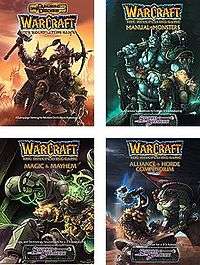Warcraft: The Roleplaying Game
|
Various book covers, all from the first edition. | |
| Designer(s) | Deirdre Brooks with Andrew Bates (1st edition); Mike Johnstone with Andrew Bates and Luke Johnson (2nd edition) |
|---|---|
| Publisher(s) | Sword & Sorcery Studios |
| Publication date |
2003 (1st edition: Warcraft RPG) 2005 (2nd edition: World of Warcraft RPG) |
| Genre(s) | Fantasy |
| System(s) | d20 System, OGL |
Warcraft: The Roleplaying Game is a role-playing game line published by Sword & Sorcery Studios in 2003, based on the Warcraft computer game (and later also World of Warcraft) and set in Azeroth.[1] The second edition is officially called World of Warcraft: The Roleplaying Game, but both editions are commonly referred to as the "Warcraft RPG" or "Warcraft tabletop" to avoid confusion with the World of Warcraft MMORPG.
All first edition books include art from renowned artists like Sam "Samwise" Didier (Art Director at Blizzard Entertainment), Travis Thammer (concept art for Warcraft III) and Chris Metzen (Blizzard's Vice President of Creative Development).
Second Edition
In 2005 White Wolf Publishing updated the rules for the game into a new edition and renamed the series World of Warcraft: The Roleplaying Game to tie in with the success of World of Warcraft, under the Open Gaming License. The Art in second edition continued to have Samwise Didier in its crew but no longer Metzen. Instead it had been praised with likewise talented artists as Glenn Rane (who also created many of the recent covers for novel books and Burning Crusade concept art). Glenn was responsible for the entire art found in the Monster Guide marking it as the only book to have just one artist.
The early version of the game was full of short stories throughout the series. There are little or no short stories printed in the new series with only the core rulebook containing a simple anecdote in the introduction to the book. This has since changed, as the Alliance Player's Guide, the Horde Player's Guide, and Dark Factions all include several short stories in the format of sidebars instead of full-pages.
Like the MMO, Chris Metzen is in charge of the lore, and he uses the books to expand upon things in his view of the World of Warcraft. Many things do not show up in the MMO, due to limitations the game's scale, and other gameplay mechanics. Metzen's personal view is that the history of Azeroth is not found in just one source, but includes the RPG, Novels, Comics, Manuals, and Games.
Most of the books are placed chronologically before World of Warcraft, and authors such as Brann Bronzebeard cover many alternate legends believed by the people of Azeroth covering various topics. Many of the books are located at earlier points in the timeline, and the culture, and population factors, and other historical events have taken place or changed since the point in time they cover.
Many cultures have changed since the period of time when the RPG books take place, and even between the events of the books. Some cultures mentioned no longer exist at the time of World of Warcraft, and some are cultures that existed thousands of years before or during the "War of the Ancients".
Still, the books of the roleplaying game were one of the major sources for lore of the Warcraft universe, and was often quoted on several Wikis related to the different games. The roleplaying game has been declared non canon.
References
- ↑ Mike Swierczek. "Review of World of Warcraft: The Roleplaying Game".
